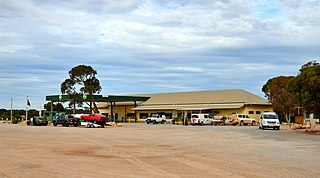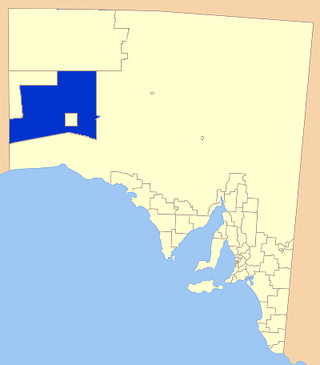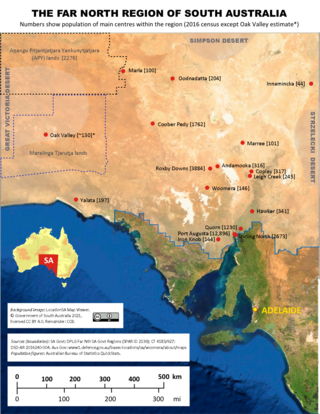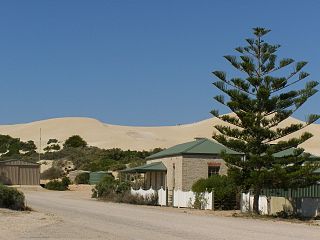
The Nullarbor Plain is part of the area of flat, almost treeless, arid or semi-arid country of southern Australia, located on the Great Australian Bight coast with the Great Victoria Desert to its north. It is the world's largest single exposure of limestone bedrock, and occupies an area of about 200,000 square kilometres (77,000 sq mi). At its widest point, it stretches about 1,100 kilometres (684 mi) from east to west across the border between South Australia and Western Australia.

Maralinga is a desert area around 3,300 square kilometres (1,300 sq mi) large located in the west of South Australia, within the Great Victoria Desert. The area is best known for being the location of several British nuclear tests in the 1950s.

The Pitjantjatjara are an Aboriginal people of the Central Australian desert near Uluru. They are closely related to the Yankunytjatjara and Ngaanyatjarra and their languages are, to a large extent, mutually intelligible.
Anungu schools is a group of ten schools operated by the Government of South Australia which are located in the west of the Australian state of South Australia. Eight are located in the Aboriginal lands of Anangu Pitjantjatjara Yankunytjatjara, while one is in Maralinga Tjarutja and on in the community of Yalata, all offering primary and secondary schooling to a local body of students who are largely Aboriginal.
Oak Valley is the only community of Maralinga Tjarutja Aboriginal Council (AC) Local Government Area (LGA), South Australia. The population fluctuates, but a 2016 survey reported around 128 people, mostly Aboriginal. It is approximately 128 kilometres (80 mi) NNW of the original Maralinga township, and lies at the southern edge of the Great Victoria Desert. It is named for the desert oaks that populate the vicinity of the community.

Ooldea, known as Yuldea and various other names by Western Desert peoples (Aṉangu), is a tiny settlement in South Australia. It is on the eastern edge of the Nullarbor Plain, 863 km (536 mi) west of Port Augusta on the Trans-Australian Railway. Ooldea is 143 km (89 mi) from the bitumen Eyre Highway.

Caiguna is a small roadhouse community located on the Eyre Highway in Western Australia. It is the second stop east of Norseman on the journey east across the Nullarbor Plain. Between Balladonia and Caiguna is a 146.6-kilometre (91.1 mi) stretch of the highway which is one of the longest straight stretches of road in the world. The unofficial Central Western Time (CWT) starts shortly east of Caiguna, heading eastward.

The Maralinga Tjarutja, or Maralinga Tjarutja Council, is the corporation representing the traditional Anangu owners of the remote western areas of South Australia known as the Maralinga Tjarutja lands. The council was established by the Maralinga Tjarutja Land Rights Act 1984. The area is one of the four regions of South Australia classified as an Aboriginal Council (AC), and its official consideration as a local government area differs between federal and state sources.

The Far North is a region that covers about 70 per cent of the Australian state of South Australia. It extends across the entire width of the state – about 1200 kilometres – for approximately the northernmost 750 kilometres. The state government defines the Far North region similarly, although it separately delineates the Maralinga Tjarutja Lands, the Yalata Aboriginal community and other unincorporated crown lands in the state's far west, which are officially considered part of the Eyre and Western region. Colloquially, South Australians regard anywhere north of Port Augusta as the Far North.
Nullarbor Regional Reserve is a protected area in South Australia located about 300 kilometres west of Ceduna.

James Yami Lester was a Yankunytjatjara man, an Indigenous person of northern South Australia. Lester, who survived nuclear testing in outback Australia, is best known as an anti-nuclear and indigenous rights advocate.
Kingoonya, originally spelt Kingoonyah, pronounced, was a small settlement, or township, now almost totally abandoned, in the central outback of the Australian state of South Australia. It was established in 1916 as a railway settlement on the Trans-Australian Railway, mainly to provide refuelling for steam trains and track maintenance services; it also served about 200 families living on sheep grazing properties in the region.

The Gerard Community Council is a small, aboriginally controlled local government area located in The Riverland, South Australia. The community is dependent on the River Murray, with some horticulture and grazing in the district. Traditional crafts are also produced in the community, with part of the community economy derived from the sale of these to tourists.
Pukatja is an Aboriginal community in the Anangu Pitjantjatjara Yankunytjatjara Lands in South Australia, comprising one of the six main communities on "The Lands".

Fowlers Bay, formerly known as Yalata, is a bay, town and locality in the Australian state of South Australia located about 658 kilometres (409 mi) north-west of the state capital, Adelaide. The town is located on Port Eyre, at the western end of the larger Fowlers Bay. It was named Yalata after Yalata station, established in the 1860s and stretching from the Nullarbor Plain across to near Streaky Bay on the Eyre Peninsula, whose homestead was located on the hill nearby. The name Yalata now belongs to a small Aboriginal community further west, which was also situated on station land.

Nundroo is a small South Australian town, located approximately 1,014 kilometres (630 mi) west of Adelaide. It is a popular rest stop for travellers due to its location on the Eyre Highway.
Point Pearce, also spelt Point Pierce in the past, is a town in the Australian state of South Australia. The town is located in the Yorke Peninsula Council local government area, 194 kilometres (121 mi) north-west of the state capital, Adelaide.
Archie Barton was an Aboriginal Australian political activist and land-rights campaigner. He played a key role in the 20-year campaign in the Maralinga Tjarutja people regaining ownership of their land, following the British nuclear tests at Maralinga, South Australia, and having the test sites cleaned up, and establishing Oak Valley with funds provided as compensation for the dispossession of the Maralinga people from their lands
Koonibba is a locality and an associated Aboriginal community in South Australia located about 586 kilometres (364 mi) northwest of the state capital of Adelaide and about 38 km (24 mi) northwest of the municipal seat in Ceduna and 5 km (3.1 mi) north of the Eyre Highway.
The Aboriginal South Australians are the Indigenous people who lived in South Australia prior to the British colonisation of South Australia, and their descendants and their ancestors. There are difficulties in identifying the names, territorial boundaries, and language groups of the Aboriginal peoples of South Australia, including poor record-keeping and deliberate obfuscation, so only a rough approximation can be given here.












